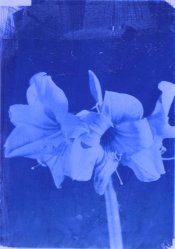Whiteymorange
Subscriber
I have been experimenting with fixed out photo paper as a substrate for cyanotype, figuring that the gelatin coating might be perfect for the process. Some success, some failures. Mostly I find that matt or pearl surfaces are better, but not always. The paper brand/type is also important, but I haven't done enough yet to have a good handle on what to avoid. I've attached two examples, one is a Bergger matt surface from the 90's, the other, the funky one, is an Ilford gloss that was given to me as scrap in 16x20 size, with the outer wrapping missing, so I can't tell you the exact type. That one was coated with a glass rod. The coating errors give it a unique look, which I quite like, but I would love to find a way to coat it evenly, since the gloss surface allows very sharp renditions, which might be useful for certain images.
So here is the question: has anyone tried silkscreen coating the cyanotype chemicals on to paper or cloth? A very tight screen and hard, sharp squeegee might be fine for such thin "ink" or, as an alternative, there may be some way to render the cyanotype chemicals more viscous.

So here is the question: has anyone tried silkscreen coating the cyanotype chemicals on to paper or cloth? A very tight screen and hard, sharp squeegee might be fine for such thin "ink" or, as an alternative, there may be some way to render the cyanotype chemicals more viscous.





 sorry, missed the context. I've been out of town and lost the train of this thread even though I'd been following it. You're right of course!
sorry, missed the context. I've been out of town and lost the train of this thread even though I'd been following it. You're right of course!